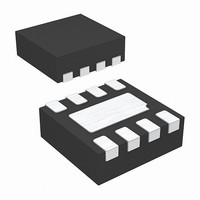ISL29002IROZ Intersil, ISL29002IROZ Datasheet - Page 8

ISL29002IROZ
Manufacturer Part Number
ISL29002IROZ
Description
Digital Output Photo IC,LLCC
Manufacturer
Intersil
Series
-r
Datasheet
1.ISL29002IROZ-EVALZ.pdf
(10 pages)
Specifications of ISL29002IROZ
Wavelength
550nm
Output Type
I²C™
Package / Case
8-WFDFN Exposed Pad
Lead Free Status / Rohs Status
Lead free / RoHS Compliant
integration is no longer fixed at 32,768, but varies with the
chosen integration time, and is limited to 65,536. In order to
avoid erroneous lux readings the integration must be short
enough not to allow an overflow in the counter register.
where:
The number of clock cycles in the previous integration period
is provided in the third and fourth bytes of data read across
the I
counter value.
When using one of the three external timing modes, the
ISL29002’s resolution varies with the integration time. The
resolution is determined by the ratio of the max lux range to
the number of clock cycles per integration.
The following equations describe the light intensity as a
function of sensor reading, integration counter value, and
integration time:
T
where L is the measured light intensity, Data1 is the sensor
reading, Data2 is the integration counter value, T is the
integration time, and R
Noise Rejection and Integration Time
In general, integrating type ADC’s have an excellent noise-
rejection characteristics for periodic noise sources whose
frequency is an integer multiple of the integration time. For
instance, a 60Hz AC unwanted signal’s sum from 0ms to
n*16.66ms (n = 1,2...n
ISL29002’s integration time to an integer multiple of periodic
noise signal greatly improves the light sensor output signal
in the presence of noise. The integration time, T
ISL29002 is set by an external resistor R
See Equation 3.
Design Example 1
Using the ISL29002, determine a suitable integration time,
T
noise. Accordingly, specify the R
I
Solution 1 - Using Internal Timing
T
and 50Hz AC rejection, the integration time needs to be
E lux
T
2
int
int
int
T
f
Not to be confused with the I
R
recommended.
int
(
C clock is at f
osc
int
EXT
, that will ignore the presence of both 60Hz and 50Hz
= n(1/60Hz) = m(1/50Hz). In order to achieve both 60Hz
= Time Interval between external time commands
<
2
)
= user defined integration time
C bus. This two-byte value is called the integration
= 300kHz*100kΩ/R
65,536
----------------- -
f
=
OSC
= user defined external resistor to adjust f
------------------------------------------ -
(
R
50 000lux
EXT
,
I2C
⁄
100kΩ
= 10kHz.
i
EXT
) is zero. Similarly, setting the
)
⋅
EXT
Data1
-----------------
Data2
is external resistor value.
. ISL29002’s internal oscillator.
8
2
C’s frequency.
EXT
value. Given that the
EXT
.
int
osc
, of the
. 100kΩ
(EQ. 5)
(EQ. 6)
ISL29002
adjusted to coincide with an integer multiple of the AC noise
cycle times.
n/m = 60Hz/50Hz = 6/5. The first instance of integer values at
which T
6.
T
From Equation 3:
R
R
and will reject the presence of both 60Hz and 50Hz power line
signals.
Solution 2 - Using External Timing
From solution 1, the desired integration time is 100ms. Note
that the R
when using external timing mode. Instead, the integration and
the 16-bit counter starts when an external timing mode
command is sent and end when another external timing mode
is sent. In other words, the time between two external timing
mode command is the integration time. The programmer
determines how many clock cycles to wait between two
external timing commands.
i
i
i
1,000 cycles after another external timing command rejects
both 60Hz and 50Hz AC noise signals.
IR Rejection
Any filament type light source has a high presence of infrared
component invisible to the human eye. A white fluorescent
lamp, on the other hand has a low IR content. As a result,
output sensitivity may vary depending on the light source.
Maximum attenuation of IR can be achieved by properly scaling
the readings of Diode1 and Diode2. The user obtains data
reading from sensor diode 1, D1, which is sensitive to visible
and IR, then reading from sensor diode 2, D2 which is mostly
sensitive from IR. The graph on Figure 9 shows the effective
spectral response after applying Equation 7 of the ISL29002
from 400nm to 1000nm. The equation below describes the
method of cancelling IR in internal timing mode.
Where:
data = lux amount in number of counts less IR presence
D1 = data reading of Diode 1
D2 = data reading of Diode 2
n = 1.85. This is a fudge factor to scale back the sensitivity up to
ensure Equation 2 is valid.
k = 7.5. This is a scaling factor for the IR sensitive Diode 2.
I2C
I2C
I2C
D3
int
EXT
EXT
= 6(1/60Hz) = 5(1/50Hz) = 100ms
= 1,000 I
= f
= 10kHz
=
= T
= 90kΩ, the ISL29002 defaults to 100ms integration time
n D1 kD2
I2C *
int
(
int
EXT
rejects both 60Hz and 50Hz is when m = 5, and n =
T
–
* (100kΩ/110ms) = 90.9kΩ. By populating
2
int
*
100ms
C clock cycles. An external timing command
resistor does not determine the integration time
, where i
)
I2C
= number of I
2
C cycles
December 1, 2006
(EQ. 7)
FN7465.2










